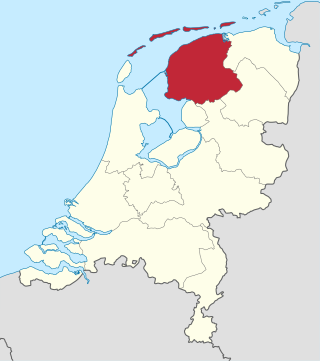
Friesland, historically and traditionally known as Frisia, named after the Frisians, is a province of the Netherlands located in the country's northern part. It is situated west of Groningen, northwest of Drenthe and Overijssel, north of Flevoland, northeast of North Holland, and south of the Wadden Sea. As of January 2020, the province had a population of 649,944 and a total area of 5,749 km2 (2,220 sq mi).

Sneek is a city southwest of Leeuwarden and the seat of the former municipality of Sneek in the province of Friesland, Netherlands. As of 2011 it is the seat of the municipality of Súdwest-Fryslân. The city had approximately 33,855 inhabitants in January 2017.

Medemblik is a municipality and a town in the Netherlands, in the province of North Holland and the region of West-Frisia. It lies immediately south of the polder and former municipality of Wieringermeer.
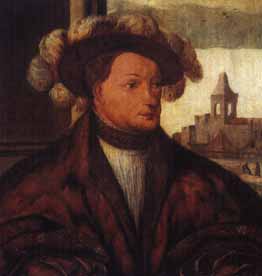
Charles II was a member of the House of Egmond who ruled as Duke of Guelders and Count of Zutphen from 1492 until his death. He was the son of Adolf of Egmond and Catherine of Bourbon. He had a principal role in the Frisian peasant rebellion and the Guelders Wars.
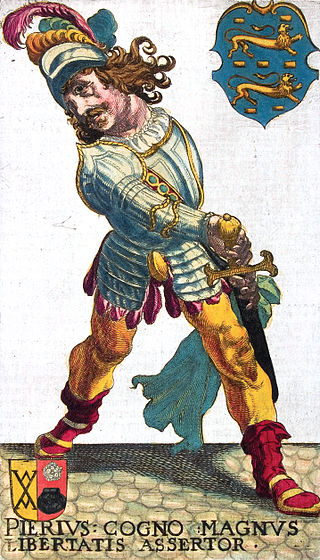
Pier Gerlofs Donia was a Frisian farmer, rebel leader, and pirate. He is best known by his West Frisian nickname Grutte Pier, or by the Dutch translation Grote Pier, which referred to his legendary size, strength, and bravery.

Wûnseradiel is a former municipality in the Friesland province of the northern Netherlands, at the eastern end of the Afsluitdijk. The official (legal) name of the municipality is in the West Frisian language, though it is known as Wonseradeel in Dutch. In 2011 it was merged with the municipalities of Bolsward, Nijefurd, Sneek and Wymbritseradiel forming the new municipality Súdwest-Fryslân.

The Zweihänder, also Doppelhänder ('double-hander'), Beidhänder ('both-hander'), Bihänder, or Bidenhänder, is a large two-handed sword that was used primarily during the 16th century.
Piers is an old English given name and surname, and has the same origins as Peter. Its meaning is 'rock, stone'.
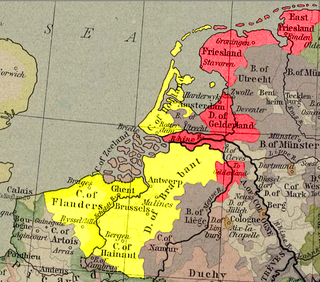
The Guelders Wars were a series of conflicts in the Low Countries between the Duke of Burgundy, who controlled Holland, Flanders, Brabant, and Hainaut on the one side, and Charles, Duke of Guelders, who controlled Guelders, Groningen, and Frisia on the other side.
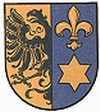
Ygo Gales Galama was a 15th-century Frisian warlord and Galama-patriarch.
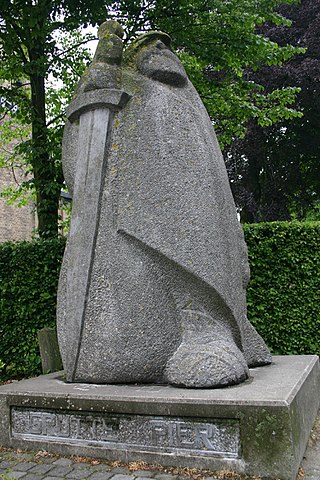
Petrus Jacobi Thaborita was a Frisian monk, historian and writer. He is best known for his writings on the Frisian freedom fighter Pier Gerlofs Donia, and for writing down Donia's last words. In the extended works by Thaborita van Bolsward is found information on the Frisian chieftains warlords Jancko Douwama and Haring Harinxma.

Arum is a village in the Súdwest-Fryslân municipality in the Dutch province of Friesland. It is about 5 km southeast of the city of Harlingen.
Wijerd Jelckama was a Frisian military commander, warlord and member of the Arumer Zwarte Hoop. He was the lieutenant of Pier Gerlofs Donia and fought along his side against the Saxon and Hollandic invaders. Jelckama took Donia's place as freedom fighter after Donia retired in 1519.

The Vetkopers and Schieringers were two opposing Frisian factional parties from the medieval period. They were responsible for a civil war that lasted for over a century (1350–1498) and which eventually led to the end of the so-called "Frisian freedom".

Frisian freedom was the absence of feudalism and serfdom in Frisia, the area that was originally inhabited by the Frisians. Historical Frisia included the modern provinces of Friesland and Groningen, and the area of West Friesland, in the Netherlands, and East Friesland in Germany. During the period of Frisian freedom the area did not have a sovereign lord who owned and administered the land. The freedom of the Frisians developed in the context of ongoing disputes over the rights of local nobility.

Frisia has changed dramatically over time, both through floods and through a change in identity. It is part of the Nordwestblock which is a hypothetical historic region linked by language and culture,where they may have spoken an Indo-European language which was neither germanic nor celtic.

Kimswerd is a village in Súdwest-Fryslân municipality in the province of Friesland, the Netherlands. It had a population of around 565 in January 2017.
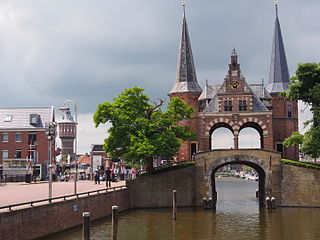
Southwest Friesland is a municipality in the Northern Netherlands, located in the province of Friesland. It had a population of 84,092 in August 2017. Sneek is the municipal seat. With a total area of 841.56 km2, Súdwest-Fryslân is the largest municipality by area in the Netherlands.
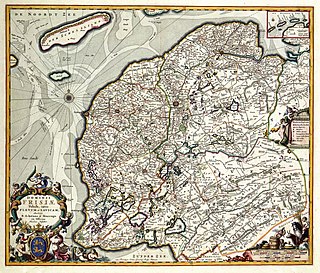
The Lordship of Frisia or Lordship of Friesland was a feudal dominion in the Netherlands. It was formed in 1498 by King Maximilian I and reformed in 1524 when Emperor Charles V conquered Frisia.















